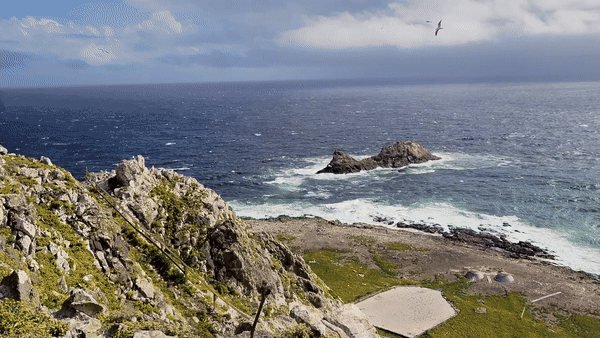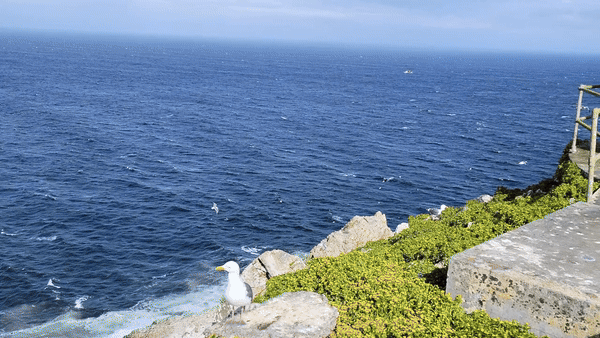Hello folks who wonder if the Farallon Islands are proof that even inhospitable rocks can become prime real estate in the Bay Area,
To recap what we covered till now.
1. Board the boat to go to the island.
 |
| Observe the SF skyline |
2. Transfer to a smaller boat.
 |
| Don't forget my Bagels and Cream Cheese from the Boat. |
3. Greet the skeptical residents.
 |
| I don't want to share my room with these new guests |
Alright, let me give you folks a house tour but before that a little bit of history.
The harsh environmental conditions surrounding the Farallon Islands, along with the scarcity of freshwater, have always made long-term habitation challenging. Historical records indicate that Russian fur hunters utilized these islands in the late 1700s and early 1800s to hunt sea otters and other marine mammals for their valuable pelts.
After this period, the islands were taken advantage of by people looking to make quick profits during the California Gold Rush. They primarily harvested the eggs of local bird species, such as Common Murres and Western Gulls. While Western Gull eggs were less popular because they were fragile and difficult to transport, Common Murre eggs became the preferred choice. Why? Because the poultry industry was not yet established, and the hungry miners needed a source of protein for breakfast every day.
Additionally, many ships coming to San Francisco would get close to the islands and hit the rocks, causing them to sink. Drinking and substandard navigation equipment likely played a role in these incidents. As a result, the government decided to create a lighthouse on the island in 1855.
The lighthouse complex included two houses for the lighthouse keepers and their families.
Today, the house on the left is used by the U.S. Coast Guard, while the house on the right serves as a residence for biologists who are constantly monitoring bird populations and doing sciency things.
 |
| Where else in the Bay Area can you find such a big backyard |
The interiors of the houses are quite ordinary, featuring typical rooms with Wi-Fi access. However, the plumbing is outdated, which means the pipes can easily get clogged if you flush toilet paper. To prevent this, you have to dispose of toilet paper in a trash bin, which is then burned weekly.
Each house is accompanied by a complimentary tree—a Monterey Cypress. Although it may seem small for a tree that was planted before the 1920s, it has survived where many others have not. The island once had over 100 Monterey Cypress trees and a few Eucalyptus trees, but the harsh winds and shallow soil have taken a toll, leaving only these two trees and another Monterey Pine that we will encounter later.
 |
| No one is TPing this tree anytime soon. |
These trees may seem ordinary, but they are actually excellent spots for spotting migrating birds who often stop here to rest and refuel after their long journeys as well as curious biologists who frequent these trees, eager to discover which new migrating species they might encounter today.
Here is a Sooty Fox sparrow that was foraging at the base of one of those trees. They say these birds are migrating, but I did not see any carry-on bags around this one. Aww, it has an injured right leg.
 |
| I hope it has purchased travel insurance. |
The Monterey Pine can reach heights of over 40 feet in the wild. However, the harsh winds on the island cause it to grow more like a shrub, spreading horizontally instead of upward.
 |
| Are you drunk, tree? |
"Where is the lighthouse?" you ask, getting impatient while I talk about the trees on the island.
Be patient, we are getting there.
Perched atop the hill behind the houses stands the lighthouse, a mere shadow of its former glory.
 |
| Looks like a water tower from a distance |
The lighthouse on the island is not the glamorous one you might have seen in shows and movies. The previous light source would unintentionally attract migratory animals like Hoary Bats. Hence this lighthouse does not have a traditional rotating beam, but instead uses a much softer pulsating light.
 |
| This Western Gull surveys its domain atop the lighthouse light |
This is what the lighthouse structure looks like up-close. Not too impressive, I agree.
That said, the view from the top of the lighthouse is stunning.
 |
| It's clear now why these islands have caused so many shipwrecks. |
Now that you're familiar with the island, feel free to explore and make yourself at home. In the next post, I'll introduce you to Morris, a solitary Northern Gannet who arrived on this island in 2012 and never left.


No comments:
Post a Comment
Did you learn something new in this post? Let us know in the comments below